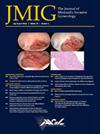Extraction Laparotomy for Specimen Retrieval Does Not Alter Same-Day Discharge Plans
IF 3.5
2区 医学
Q1 OBSTETRICS & GYNECOLOGY
引用次数: 0
Abstract
Study Objective
To evaluate whether extraction laparotomy (EL) for intact specimen removal adversely affected the feasibility or safety of same-day discharge (SDD) in patients undergoing minimally invasive surgery (MIS) for confirmed or suspected gynecologic malignancies.
Design
Retrospective study.
Setting
Single-institution study.
Patients
Patients undergoing MIS for gynecologic malignancy at a single institution, who underwent EL (N = 67) and age-matched controls (N = 134).
Interventions
Comparing SDD rates, complications, readmission, and outpatient follow-up after between patients requiring EL and those who did not after minimally invasive gynecologic surgery.
Measurements and Main Results
A total of 1224 patients were identified. Sixty-seven patients underwent EL for specimen extraction. From the remainder, 134 patients were selected as age-matched controls. SDD rate was 83% (EL) vs 87% (no EL) (p = .39). There was no difference in median pain scores (1.8 vs 1.9 p = .86), length of stay (0 days for both) (p = .41), 30-day readmission rate (6% vs 3%) (p = .45), emergency department visit (13% vs 10%) (p = .76), or any patient contact (34% vs 39%) (p = .53), between the groups. Specimen weight was higher for EL (524 g vs 142 g, p <.001), as was estimated blood loss (104 mL vs 46 mL, p <.001), and surgery time was increased by 22 minutes in the EL group (121 min vs 99 min, p <.001). Patients who underwent EL did require more narcotics in postanesthesia care unit (20.5 vs 12.2 oral morphine equivalent, p = .033); however, this did not translate to increased number of narcotics prescribed at discharge. On logistic regression, a higher specimen weight trended to increase the likelihood of admission (odds ratio, 1.04; confidence interval, 1.01–1.08); however, surgery time, time in postanesthesia care unit, race, body mass index, surgery type, or need for EL did not predict SDD or need for admission.
Conclusion
MIS patients who require EL can still achieve SDD. SDD is safe and feasible without increased risk of readmission, pain score, or unscheduled patient contact postoperatively.
提取标本的腹腔手术不会改变当日出院计划。
研究目的评估因确诊或疑似妇科恶性肿瘤而接受微创手术(MIS)的患者,因完整标本取出而进行的开腹手术(EL)是否会对当日出院(SDD)的可行性或安全性产生不利影响:回顾性研究患者: 接受微创手术的患者在单个机构接受微创手术治疗妇科恶性肿瘤的患者(67人)和年龄匹配的对照组(134人):比较微创妇科手术后需要拔管开腹的患者与不需要拔管开腹的患者的当日出院率、并发症、再入院率和门诊随访率:共确定了 1224 名患者。67名患者接受了EL标本提取术。其余 134 名患者被选为年龄匹配的对照组。SDD率为83%(EL)对87%(无EL)(P=0.39)。两组患者的疼痛评分中位数(1.8 vs. 1.9,p=.86)、住院时间(LOS)(两组均为 0 天)(p=.41)、30 天再入院率(6% vs. 3%,p=.45)、急诊室就诊率(13% vs. 10%,p=.76)或任何患者接触率(34% vs. 39%,p=.53)均无差异。EL组的标本重量更高(524克对142克,p结论:需要开腹取材的微创手术患者仍可实现 SDD。当天出院是安全可行的,不会增加术后再入院风险、疼痛评分或计划外的患者接触。
本文章由计算机程序翻译,如有差异,请以英文原文为准。
求助全文
约1分钟内获得全文
求助全文
来源期刊
CiteScore
5.00
自引率
7.30%
发文量
272
审稿时长
37 days
期刊介绍:
The Journal of Minimally Invasive Gynecology, formerly titled The Journal of the American Association of Gynecologic Laparoscopists, is an international clinical forum for the exchange and dissemination of ideas, findings and techniques relevant to gynecologic endoscopy and other minimally invasive procedures. The Journal, which presents research, clinical opinions and case reports from the brightest minds in gynecologic surgery, is an authoritative source informing practicing physicians of the latest, cutting-edge developments occurring in this emerging field.

 求助内容:
求助内容: 应助结果提醒方式:
应助结果提醒方式:


